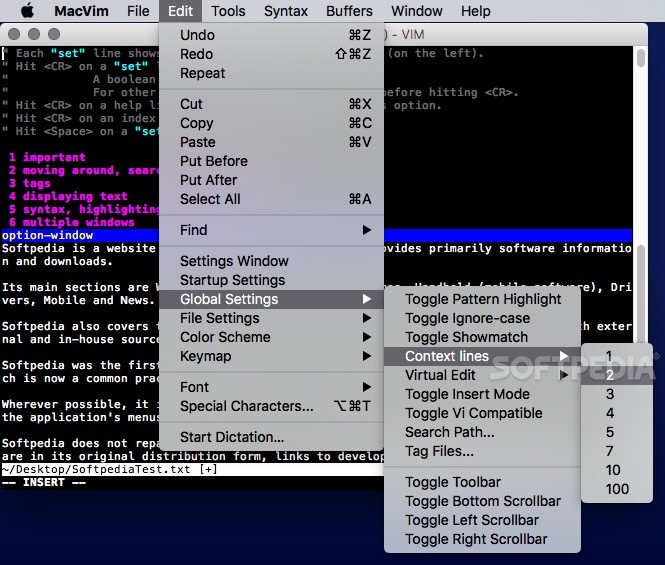

- #OPENING MACVIM THROUGH TERMINAL INSTALL#
- #OPENING MACVIM THROUGH TERMINAL SOFTWARE#
- #OPENING MACVIM THROUGH TERMINAL WINDOWS#
Remember that brew is also implemented on Linux so it makes sense to have this division. Despite the similar syntax, the set shell/bin/bash does not apply to shell variables, but to variables that are internal to vi, so you can run a shell even if the systems shell for the active user is not a real one.
#OPENING MACVIM THROUGH TERMINAL SOFTWARE#
In a nutshell, brew handles software at the unix level, whereas brew cask extends the functionality of brew into the macOS domain for additional functionality such as handling the location of macOS app bundles. UPDATE: A bit of clarification about brew and brew cask.
#OPENING MACVIM THROUGH TERMINAL INSTALL#
You should then be able to launch MacVim like you do any other macOS app, including mvim or open -a MacVim from a terminal session. As an example, lets install the websearch plugin that allows you to search on the internet straight from the terminal. Instead, please consider using brew cask andįor MacVim, you can install with: brew cask install macvim Has anyone else had this problem Is this happening because I'm opening MacVim using Alfred If so, is there a way to fix it Thanks. Spotlight usingĮither aliases or symlinks and Homebrew formulae do not build "proper". On the other hand, if I were to open and terminal window and change to the directory where the file is located and open it using MacVim from the command line 'mvim -v somefile.txt', all my vim settings are present. Unfortunately brew linkapps cannot behave nicely with e.g. Now whenever you’re in Terminal and want to open a file with mvim. Then we’re going to move the mvim file to /usr/local/bin by typing in this command from the terminal: mv mvim /usr/local/bin/.

You can also use the menuing system for your graphical environment. After installing MacVim by dragging MacVim.app to the Applications folder, open up terminal and navigate to the uncompressed folder that has mvim. You may even get the following warning if you brew linkapps: First, you can the graphical version of Vim from the command line by typing GVim. So far, my best solution is to launch MacVim using an alternate application launcher, which you can create using AppleScript like so: Create an apple script like by Running 'Script Editor', clicking 'New Document', and supplying the following: tell application 'Terminal' do script 'open -a MacVim.

app bundles, you should install them via cask, if available, as using symlinks can cause issues. If you call the script and there's no existing gvim window, a new one will be created.For Mac. (I believe MacVim comes with a similar 'mvim' script you can use on OS X) If you don't want files to open in tabs, change "remote-tab-silent" to "remote-silent". If anyone's interested in opening files in an existing gvim window from the terminal, here's the script I use in Linux: The reason I've never felt the need for a file-browser plugin in Vim is because I've always used Vim with an external file-browser. You can associate a file extension with an app (such as MacVim) via the 'Info dialog'. export PATH'/bin:PATH' Then execute source /.bashrc This will place mvim in your PATH so that you can execute it. The Vim window gets used for editing (of course), the terminal is used for running test suites and exploring the codebase and finding and opening files in Vim. Macvim normally is opened from the command line with mvim If you take the mvim script that came with MacVim and plave it in /bin (or symlink it if you prefer) Then in your /.bashrc add the following line. But when launching from Finder (either Cmd-space and typing MacVim.app, or double clicking the app bundle from the Applications folder, the app runs it creates an icon in the dock. name mvim Mine was in /Applications/MacVim-snapshot-64/mvim. When I launch MacVim using the mvim script from Terminal, it launches the app and renders a GUI window. how these look in the following figure (terminal Vim is on the top MacVim is.
#OPENING MACVIM THROUGH TERMINAL WINDOWS#
I've always been a little puzzled by people who use a file-drawer or file-list or similar addon with Vim, and I now I think I know why: I'm guessing most of these people have Vim open as their One Tool, much like another programmer might have Xcode or Visual Studio open as their One Tool, and they want to get everything done in it.Īt work, I usually have at least two windows open at all times: Vim full-screen on one monitor, a terminal full-screen on the other-or sometimes one terminal taking up most of the screen and another smaller terminal tailing a logfile. You can locate the file by using find from your root directory. In the following sections, I'll discuss some of the features that you can.


 0 kommentar(er)
0 kommentar(er)
